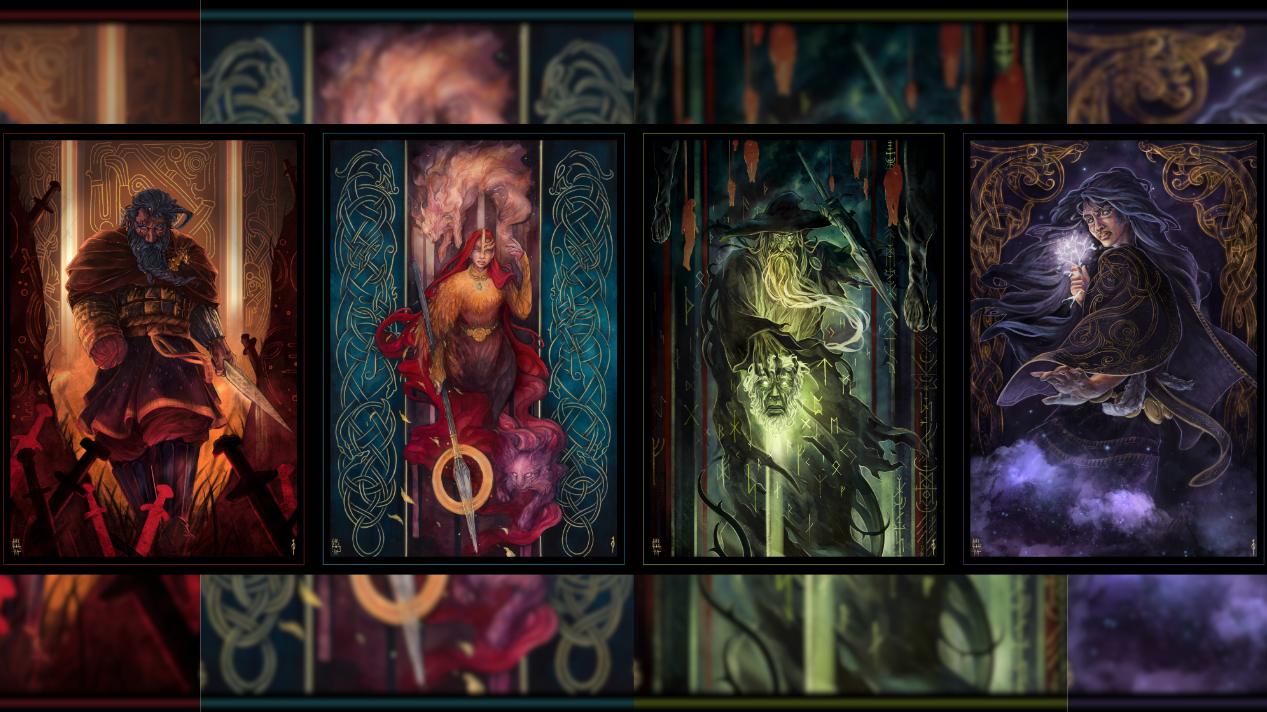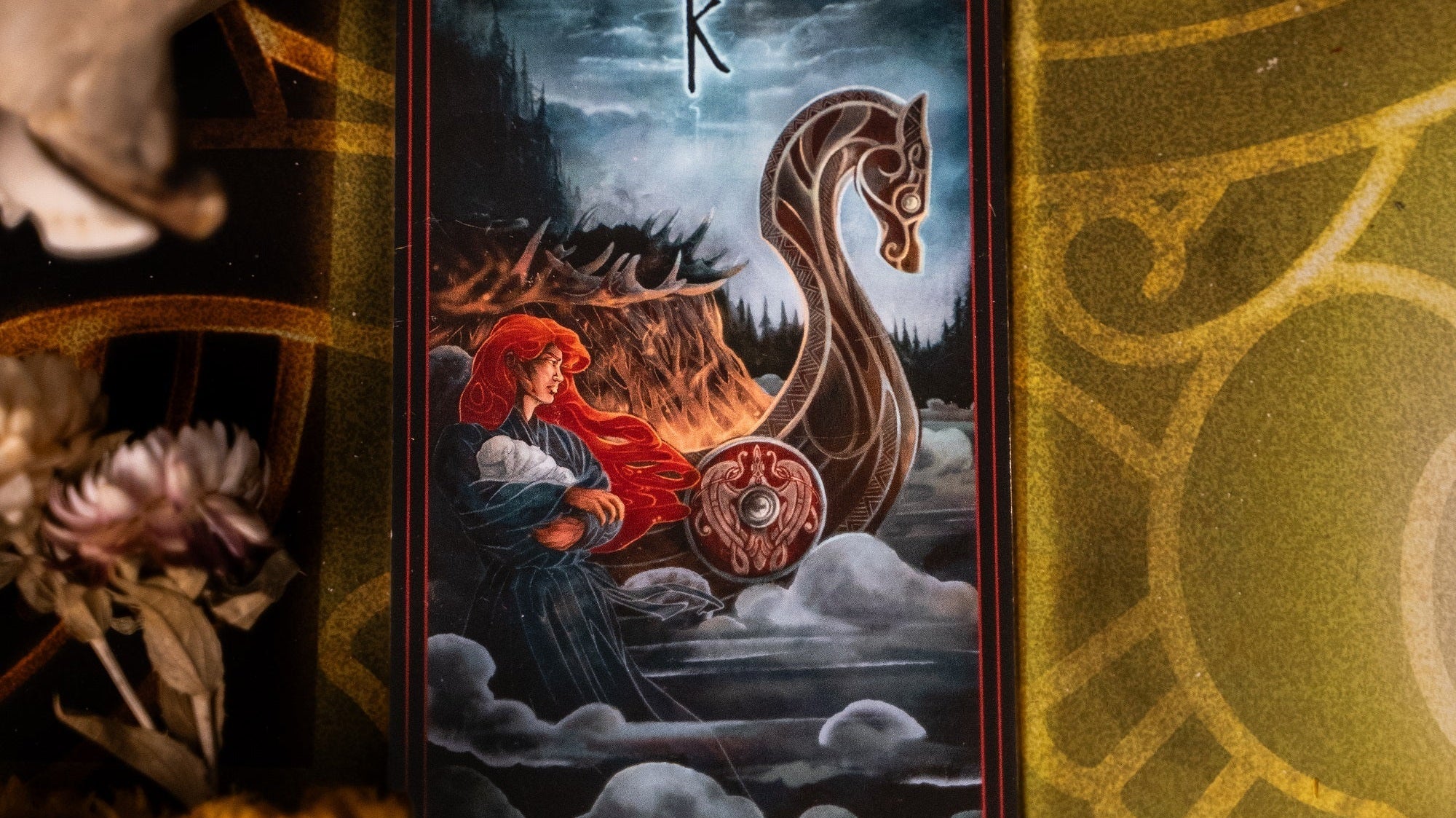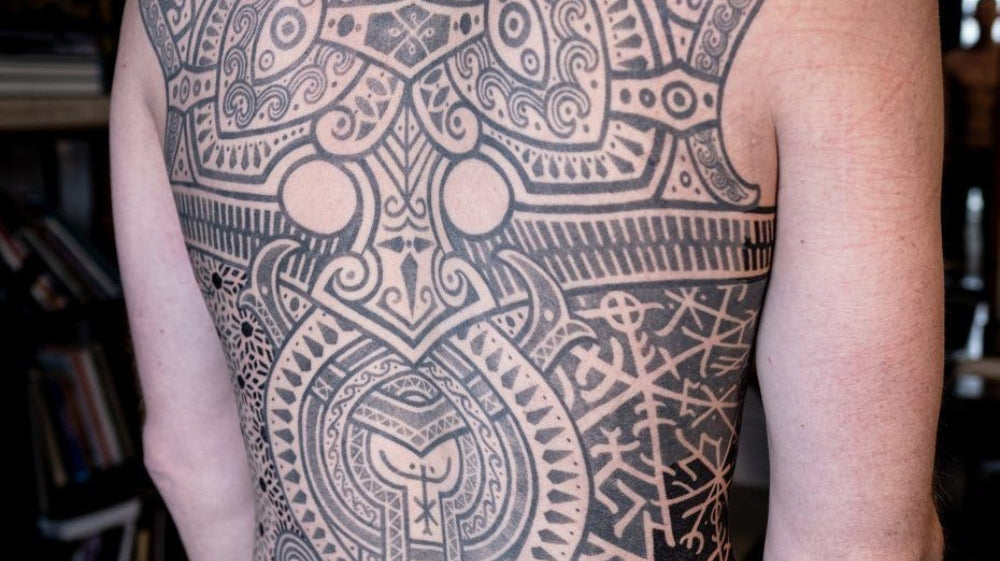Elder Futhark, Younger Futhark, Germanic runes and dwarven runes of Tolkien, why are these symbols being used in art, tattoos and stories more and more often?
Well, we shall explore that below, but first, be warned, this will be nerdy, it will pertain to magic, esoteric ideas and of course the history of written language!
The runic languages are sets of related alphabets that are native to the Germanic people. They were used before changing and adopting the Latin alphabet, and were used well into a period where the Vikings had extensive contact with Latin-writing cultures. Since the very inception of runes around the year 150, they have been evolving into what we now separate into several categories. We can somewhat safely assume that the runes did not originate in Scandinavia, but that they were refined and to an extent systemised in Scandinavia. Initially, there were 24 runes in the alphabet, based on writing symbols, mainly Latin letters, Phonecian and Etruscan. This alphabet is called the Futhark (elder), named after the first six runes.
The runic alphabet has, just like the Latin alphabet, several variations, based on age and on location. We have the Elder Futhark (c. 150-800 AD), the Anglo-Saxon Futhorc (400-1100) and the Younger Futhark (800-1100). The younger Futhark is divided into the longer-branched runes and they were specifically used in specific areas to what we now know as Scandinavia, short-branched runes called Rok that was used what we now know as Denmark and another one is Stavlosa or Halsinge runes (the staveless runes). The Younger Futhark specifically later developed further into mediaeval runes (1100-1500) and Dalecarlian runes (c. 1500-1800). It is well worth noting that some runes vary in design depending on location, and some runic alphabets have further variations than listed above. There are more than 4000 runic texts in historical archived and on stone carvings, so there is room enough for there variables.
The runes had two functions, one was wreathed in mystery, as they tied into the magical powers of the gods, and the other is the more mundane task of writing and spelling, although this as well carried huge significance to the ancient Scandinavians.There are theories amongst scholars that the runes were created as magical symbols before they were employed as a means of writing, although it remains a theory.
Writing Runes
The runes were of course used for writing and spelling as a powerful thing, writing poetry, carving memorial stones, messages and even stories. Back then they were not restricted to the very few, but by no means were they seen as a common thing amongst men. If you had the gift of commanding the written word, you were sure to be able to make a living for yourself, even though the main tradition for storytelling was in oral traditions. See, any rich Jarl or dedicated Viking warrior would wish to be commemorated on a runestone, to have one's name live on forever. Having any sort of written statement or written actions of oneself was important and crucial if you want you or your actions to be remembered past your own lifespan. But even the ability to send a message to another person was a valuable thing.
There are historical examples of texts hallowing heroes and noting the deeds of kings, as well as lewd poetry and silly scribbles.
Codex Runicus. Photo taken form University of Copenhagen
Magic
Unlike the Latin alphabet, the runes themselves are more connected to a concept, a thing that lives in the world around us, a construct or a thing. They each have their own name alongside their pronunciation, and the name carries significance and power. In Norse mythology, the runes were either a cornerstone in sagas, or a very important element of the stories that were told about the Gods.
But why this sacred position for an alphabet?
Well, as mentioned above, there is a likelihood that the runes were magical symbols before they were an alphabet, which would explain the incredible stories that focus around them, many of which involves Odin, Wodan, Wotan, call him what you will, essentially trying to steal the runes from either the cosmos or from the more primaeval forces of the nine realms.
Below are listed all 24 runes of the Elder Futhark, as well as their meaning as deduced from the Icelandic and Norwegian rune poems, as well as modern interpretations.
Once Christianity started spreading, the use of runes since then was heavily believed to be connected to paganism even though runes have been used for inscribing many Christian prayers and decorated hundreds of Christian artefacts. And within this context as well, it is specifically noteworthy that even some Christians seem to have ascribed some magical prowess to the runes, as they were often used for magical formulas.

Mighty Tales of the North - Odin Print Artwork
Noteworthy detail - The Celts, the Druids and inheritors of these people do not have a historical use of the runes, but this does not prohibit the idea, nor the use of them for them, or anyone else for that matter. The runes are not a secret to be kept for Scandinavians alone.
Runes Today
There definitely is a spike in popularity of runes in the new millennium, from the pagan movements picking up more interest in the mystical and shamanic, to people reconnecting with their heritage. What we can say is that we have noticed a high interest in runes and bindrunes on social media and through our work with and from people who are trying to reconnect to their roots, be more connected to nature and oneself.
It is not illogical for humans to seek their history and heritage when life becomes too full of noise and groundlessness, and it is safe to say that we in the West suffers from this now, more than ever. So, the runes are wonderful reminder of our past, and to many they are simple and logical tattoo choices. Isar himself still has his first tattoo, the Tiwaz rune, tattooed on his wrist.
So, whether you have been liking and researching runes since Lord of the Rings came out (like some members of the Northern Black Team) or you’ve seen them around while reading Norse Mythology, playing Norse inspired video games or just here to learn about them for the first time, we hope you enjoyed this blog, and that is brings you good ideas and service.
Why are runes so special to us and why do we, as a company use them?
At Northern Black, we work with runes because it aligns so well with what we do - We grow roots and ties to the past. Many clients come to us for our work with the runes, either small elements of larger designs or entire sleeves focusing on the runic designs Isar Oakmund is well known for.
In this, the runes can be used for anything from spelling the name of a loved one, to extensive bindrunes symbolising one's journey through life.
Out of our team, Isar has been working with runes the longest, having two decades of experience and still enjoys the process of integrating this ancient magical symbols into his tattoo-work. Lately, he has been joined by his partner May Oakmund, who has an innate ability to work with runes. She used to work with them some years ago, and has now picked it up again, working with the runes extensively every day, she recently wrote a book on the subject of Bindrunes for Love, Loss and Lust, and will continue to work with Isar on more projects, as well as creating commissions.
Both of them have been doing custom bindrune commissions for the past year and a half, for people all over the world, as it’s become a very popular way to reconnect to your heritage and history.
We ourselves in the company believe in the magical means to connect with yourself, we also see them as what they are: a phonetic alphabet that started out as magical symbols tied into a much more ancient way for humanity to exist, a way that shares the roots of the mountains and moss of the forests.

List of Runes
Below, we are going to show you the Elder Futhark runes and the explanations of each rune. Please keep in mind that some of these ideas are more modern, others are over 1000 years old and some sit well in between, making the meanings somewhat hazy on occasion. Much has been derived from the Icelandic and Norwegian Rune poems of the middle ages.

FEHU - “F” - Cattle. This rune is a symbol of wealth. A sign of economic and/or material gain. It symbolises abundance, good fortune, success and generosity.

URUZ - “U” - Auroch. A symbol of strength, survival, physical power, independence. This rune represents life force, endurance, will, courage and determination.

THURS / THURISAZ - “Th” - Thorn. This often represents reactive force, nature’s power which is indestructible. It is a symbol of self defence, freedom, strength and protection.

ANSUZ - “A” - Odin. A sign of divine wisdom, insight and inspiration. The rune of communication, speech, creativity, persuasion and the divine.

RAIDŌ / RAIDO - “R”- Travel. This rune symbolises journeying, evolution, progress. A symbol indicative of moving forward, but also literal movement and travel.

KENAZ / KAUNAZ - “K” - Torch. This rune symbolises fire, passion, enlightenment, creativity and vision. A torch in the darkness to light a path or a candle to kindle a passion.

GEBO - “G” - Gift. A rune for gifting, dedication and relationships. This rune symbolises sacrifice, honour, respect and appreciation for both mortal and divine.

WUNJO - “W” - Joy. A symbol of hope and harmony, pleasure and improvement. This rune carries all elements of love, friendship, kinship and fellowship.

HAGALAZ / HAGAL - ”H” - Hail. Destruction, opposition and catastrophe is seen in this rune. An uncontrollable force of change, but within there may be an opportunity.

NAUTHIZ - “N” - Need. A symbol of necessity and innovation, survival and endurance. A rune meaning restraint, life lessons and consequence are imminent.

ISA - “I” - Ice. Beautiful and treacherous. A rune of harshness, frustration, conflict and challenges. This is a symbol that self control and focus is needed.

JERA - “J” - Year. A symbol of the turning of the year, a fruitful harvest, peace and prosperity. The rune for hope, patience, growth and gain, but also foresight.

EIHWAZ -”Ei” or “Y” - Yew Tree. Rune of the mysteries of life and death. Symbol of stability, toughness, resistance, strength, sturdiness, and trust, poison, immortality, and eternity.

PERTHRO - “P” - Feminine magic. This rune of fate and un-manifest. A sigh of probability and luck. A symbol for games, loyalty and chance.

ALGIZ / ELHAZ - “Z” - Elk. A rune for self defence, shielding and protection. This essential link with the higher self and divine connection.

SOWILO - “S” - Sun. Rune of the rising sun, victory, guidance and goal setting aiming for higher purposes. A symbol of femininity, honour and optimism.

TIWAZ - “T” - Tyr, The rune of individual sacrifice for greater good. A sign of bravery, courage and just victory. Also signifies obedience, law and systems.

BERKANO - “B” - Birch. The rune of birth, of becoming, continually growing. A sign for sanctuary, plant life, beauty, fertility, female sexuality and wisdom.

EHWAZ - “E” - Horse. This rune symbolises trust, cooperation and teamwork. A rune for love, loyalty, travel, a common goal and carrying a burden well.

MANNAZ - “M” - Mankind. This rune represents humanity, the mind, memory, intellect, culture, and higher self. A reminder to be what we are and not overreach.

LAGUZ - “L” - Water. A rune for intuition and psychic powers. Representing the subconscious, dreams and imagination, but also healing of ourself.

INGUZ / INGWAZ - “ng” - The God. This rune represents male fertility and masculinity as well as being symbolic of nature, agriculture, peace and plenty.

OTHALA / ODAL - “O” - Heritage. This rune represents owning and claiming land, of estate, ancestry and tradition. It is symbolic of greater peace, inheritance and family.

DAGAZ - “D” - Day. A symbol for enlightenment, clarity and revelation. A sign of hope, comfort, warmth and safety, all found in the light of day, in the known.
Sources:
Runes, Sigils, and Bindrunes by Isar Oakmund
Wikipedia for exact years for Runic Languages.
If you enjoyed this read, consider subscribing to our newsletter where you can get posts like this delivered to you !





